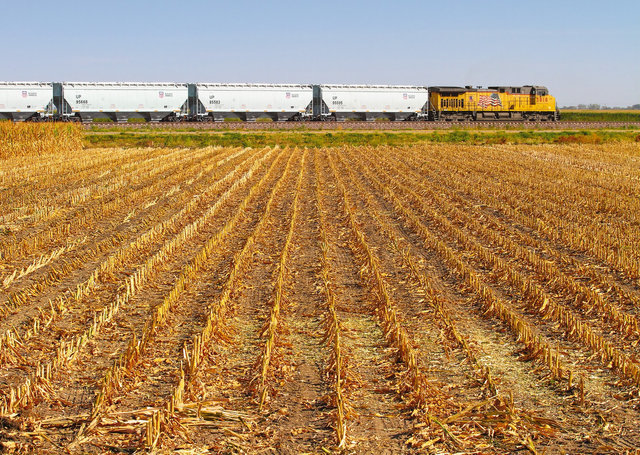July 13, 2021
What Is a Covered Hopper Rail Car?
Long ago, granular bulk commodities like wheat and sugar traveled in box cars. At the time, box cars were the best option for shipping dry bulk commodities by rail, as they provided protection from moisture. But then, a better option arrived: covered hoppers, which combined the protection of boxcars with the easy loading and unloading hoppers provide. With a protective roof and openings at the bottom that allow products to flow through using gravity, covered hoppers became the preferred way to ship dry bulk commodities in need of protection from the elements.
What Is a Covered Hopper Used For?
Covered hoppers are typically used to ship dry bulk commodities, like corn, wheat, barley, fertilizer, soda ash, cement, sand, roofing granules, rice and sugar.
What Does a Covered Hopper Look Like?
Covered hoppers look just like traditional hopper cars, with fixed sides and ends, but instead of an open top they have roofs with airtight hatches that protect the contents inside from the elements and other contaminants.
The inside of a covered hopper has anywhere from two to four separated bays, which can be loaded and unloaded individually. The number of bays a covered hopper has depends on the weight of the product: heavier products travel in covered hoppers with fewer bays.
The bottom of a covered hopper has chutes (also known as “gates”) that can be opened to unload the product. Each bay has its own chute, and these chutes are angled so product can flow through quickly and easily.

Why Do Hoppers Need Covers?
Unlike commodities like coal or gravel, which can travel safely in open-top hoppers, the products that ship in covered hoppers could be damaged or compromised if they’re exposed to the weather or other contaminants. For instance, if dry cement were mixed with rain water in transit, it would change the nature of the product and make it impossible to unload. If grain met with rain, it could rot. And if sugar or rice encountered dust, it could make it unsafe for consumption. Covered hoppers have metal tops with waterproof loading hatches that prevent situations like this from happening.

What Are the Different Covered Hopper Rail Car Types?
Covered hoppers come in three types: small, large and food-grade.
- Small covered hopper: Small covered hoppers have two bays and two gates and typically carry heavier products like cement, roofing granules and sand. Small covered hopper cars are 42 feet in length and can carry loads ranging from 207,000 to 233,000 pounds.
- Large covered hopper: Large covered hoppers have three bays and three gates and typically carry commodities like corn, wheat, barley, fertilizer and soda ash. Large covered hopper cars are 60-65 feet long and can carry loads ranging from 197,000 to 224,000 pounds.
- Food-grade covered hopper: Food-grade covered hoppers have three or four bays and feature double outlet gates to reduce exposure to contamination. They also have lined interiors to keep conditions safe for food products like rice, malt and sugar. Food-grade covered hopper cars are 60-65 feet long and can carry loads ranging from 197,000 to 222,000 pounds.
How Is the Covered Hopper Loaded and Unloaded?
Covered hoppers are loaded from above and unloaded from the bottom of the rail car. The roofs of covered hopper cars have airtight hatches that can be opened during loading, then closed to protect the product during transit. There are three types of hatch covers: round, trough and hybrid. Round covers reduce exposure to the elements and dust contamination. Trough covers run the length of the car, allowing for greater flexibility when loading the product. Hybrid hatches combine the trough and round designs, so the car be used at either style of loading facility.
Covered hoppers are self-clearing, meaning they rely on gravity for unloading. During unloading, sloped floors and doors that open at the bottom allow product to flow through. This method of unloading is also known as the “sliding gate” method.
Food-grade covered hoppers can have two options for unloading: the sliding gate method or through pneumatic transfer. For the latter, food-grade covered hoppers use a pneumatic pressure system to unload commodities under tightly-sealed conditions to keep them safe from any contamination.

Covered Hopper Fun Facts
- Traditionally, covered hoppers are white, brown or light grey, but some come in more vivid colors, like pink and bright blue.
- Long trains made up only of brown covered hoppers are referred to as “worm trains” by rail fans.
- A single covered hopper carries enough grain to make 258,000 loaves of bread.
Learn More
To learn more about covered hoppers or shipping dry bulk goods by rail, get in touch.
Want to learn more about other types of rail car equipment, including auto racks, boxcars, flatcars and gondolas? Check out our rail car type guide.
Related Articles